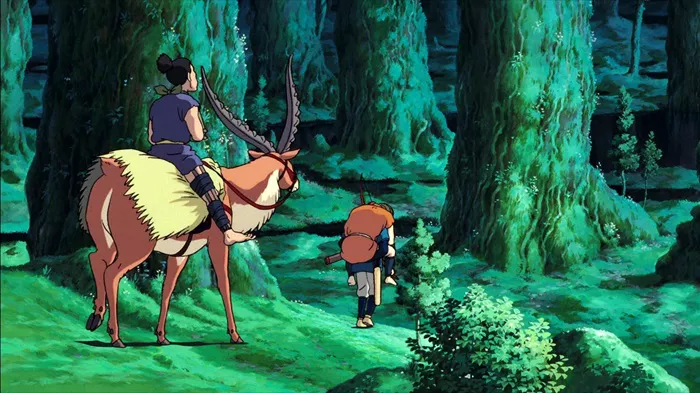Princess Mononoke,” directed by the legendary Hayao Miyazaki and produced by Studio Ghibli, stands as one of the most ambitious and revered animated films in cinema history. Released in 1997, this film not only pushed the boundaries of animation technology but also tackled complex themes of environmentalism and humanity’s relationship with nature. The creation of “Princess Mononoke” was a monumental task that involved years of development, innovative animation techniques, and the collective effort of hundreds of artists and professionals. This article provides an in-depth exploration of the production process of “Princess Mononoke”, shedding light on the time, dedication, and challenges involved in bringing this masterpiece to life.
Conceptualization and Pre-production
The journey of “Princess Mononoke” began long before the first frames were animated. Hayao Miyazaki, known for his meticulous attention to detail and profound storytelling, embarked on this project after being inspired by the lush landscapes and rich history of Japan’s ancient forests.
Initial Concept and Inspiration
Miyazaki’s inspiration for “Princess Mononoke” stemmed from his desire to create a narrative that reflected the conflict between the natural world and human industrialization. The story evolved from his earlier concepts and sketches, some dating back to the late 1970s. The character of Ashitaka, the film’s protagonist, was inspired by the Ainu people of Japan, which influenced his depiction as someone caught between the worlds of humans and gods.
Script Development
Miyazaki began the scriptwriting process in earnest in 1994. Crafting the screenplay involved extensive research into Japanese history and folklore, ensuring the authenticity and depth that the story demanded. The script went through several revisions to balance its environmental message with the compelling character-driven narrative Miyazaki envisioned.
Animation Production
The animation of “Princess Mononoke” was a labor-intensive process that utilized both traditional hand-drawn techniques and pioneering uses of computer-generated imagery (CGI).
Art and Design
The visual style of “Princess Mononoke” was influenced by historical and natural elements. The design team, led by Miyazaki, spent considerable time ensuring that every detail, from the characters’ costumes to the architectural styles of buildings, accurately reflected the period setting. Additionally, the team undertook field trips to forests around Japan to draw inspiration from the natural scenery.
Character Animation
Studio Ghibli’s animators faced the challenge of bringing an extensive cast of complex characters to life. Each character, from the enigmatic San (the Princess Mononoke herself) to the various animal gods, required detailed animations that conveyed not only physical movement but also profound emotional expressions. This required animators to push beyond traditional techniques, experimenting with new methods to capture the intensity of the film’s epic battles and tender moments.
Incorporating Computer Graphics
“Princess Mononoke” was one of the first Studio Ghibli films to integrate CGI with traditional animation. The studio used computer graphics to enhance certain elements, such as the demon curse that afflicts Ashitaka and some of the background elements during action sequences. This integration allowed for more dynamic and visually striking scenes, though Miyazaki ensured that the use of CGI did not overshadow the hand-drawn artistry that was synonymous with Studio Ghibli’s style.
Sound Design and Music
The auditory elements of “Princess Mononoke” were as meticulously crafted as its visual components. Joe Hisaishi, Miyazaki’s long-time collaborator, composed the film’s haunting and beautiful score.
Music Composition
Hisaishi’s compositions for “Princess Mononoke” drew on elements of traditional Japanese music and Western orchestral arrangements, creating a rich, emotive soundtrack that perfectly complemented the film’s themes and settings. The music played a pivotal role in building the atmosphere and supporting the emotional weight of the narrative.
Sound Effects
The sound design for “Princess Mononoke” was crucial in bringing the animated world to life. From the sounds of rustling leaves in the forest to the clanging of swords in battle, every sound effect was carefully created and placed to enhance the realism and immersion of the film.
Post-production and Release
After the intensive animation and sound design phases, “Princess Mononoke” underwent a thorough post-production process to ensure that every element met Miyazaki’s exacting standards.
Editing and Final Touches
The editing process involved refining the film’s pacing, ensuring narrative coherence, and integrating the various elements of animation, music, and sound effects into a seamless whole. This phase also included the addition of voice performances, which were recorded by an acclaimed cast of Japanese actors.
Release and Reception
“Princess Mononoke” premiered in Japan in July 1997. It was an immediate critical and commercial success, breaking box office records and garnering international acclaim. The film’s impact was significant, influencing not only the world of animation but also broader discussions about environmental issues and the role of art in social commentary.
Conclusion
The production of “Princess Mononoke” took approximately three years from the start of scriptwriting to its release, with several more years of preliminary concept development. This extensive timeline reflects the dedication and meticulous care that Hayao Miyazaki and Studio Ghibli invested in creating a film that was both a technological breakthrough and a profound artistic achievement. “Princess Mononoke” remains a landmark in animation history, celebrated for its intricate storytelling, deep themes, and breathtaking animation. The journey of its creation is a testament to the power of visionary artistry and its ability to inspire and resonate with audiences around the world.


